Adventures in Albania: dangling beneath the Kelmend Mountains, September 2017
Yes, this is nearly 3 years too late, but better late than never and it has given me something interesting to do.
As my degree had officially ended and I wasn’t employed, the latter half of 2017 was a time of immense leisure and carefree caving. When not caving, I spent quite a sizeable amount of this time looking at Google Earth for holes in the ground around the globe, and browsing the web and the university caving club library for hints of where the next caverns measureless might be found. After making some initial enquiries on UKCaving, I received a message somewhat out of the blue in August after getting back from the annual CUCC trip to Austria.
“Noticed that you were asking questions about caving in ALbania. A group of us from the Eldon [Derbyshire-based caving club] will be heading out there at the end of September. We’ve been out every year since 2009 and have some good stuff on the go, particularly if you like big, cold and vertical. Looking at around 10 days or so this time. Accommodation in a local farmhouse is sorted, most kit is out there already and all you need is personal gear really. Based in Lepush(e) in the far north. Fly direct to Tirana from LGW. Proper expedition stuff i.e. no chance of rescue unless you do it yourself, most locals are armed and there is often someone who will carry your bag up the hill…”
It was hard to think of a more interesting way to spend 10 days. I confirmed my interest and asked George and Luke if they would like to come as well. George and I arranged to meet Dave (my contact) for a quick trip into Gaping Gill to get to know him a bit and discuss how the trip would go. Dave was very easy-going and friendly, which was handy as we came across as total muppets, with George forgetting his oversuit and helmet and light and myself attempting to abseil down the entrance pitch of Stream Passage Pot without my leg loops done up. In terms of the trip, everything sounded just about as adventurous and unknown as it gets within Europe, and I knew very little about Albania and was keen to learn more about the country. We agreed happily to come out in a months time, quite surprised at the speed at which things had happened.
There would only be six of us: the Lads from Leeds with a Lust for Life and three Eldon cavers. Dave and Barny (aka Martin Barnicott) had initiated the Eldon’s explorations in the area on a recce trip in 2009, but after a year of interest from the rest of the Eldon in 2010 they seemed to have been the only consistent attendees. Barny sounded like quite a character, a former Himalayan mountain guide and now oil rig safety inspector living in southern France. I felt very psyched for the trip, though slightly nervous at the sound of no rescue, since all my previous alpine caving had been done in areas with well developed rescue teams. Having Barny’s rigging knowledge and Dave’s nursing background on the team did quite a bit to calm the butterflies at least. Anyway, we were young, we were physically fit. We were challenging logic. Nothing could possibly go wrong.
Albania is possibly the least well-known country in Europe, something that is not so surprising when it’s long history of repression and global isolation is considered, which extends to times long before the relatively well-known rule of the dictator Enver Hoxha. I’ve been reading a book titled ‘The Albanians’ by Miranda Vickers which Nadia bought me afterwards in a charity shop and because I found it very interesting, I’ve provided a brief historic backdrop here. If this isn’t of interest to you then skip over this section.
The longest period of Albania’s recent history was spent ruled by the Ottoman Empire, from the 1300s until the Empire’s collapse just prior to WW1. With them, the Ottomans brought Islam, which was adopted (at least superficially) by much of the countries previously Christian (Orthodox and Catholic) population. The Ottomans carefully prevented the Albanian people from developing a national consciousness despite two concerted efforts to dispel them. The first was in the 1400s when a 25-year revolt was led by Skenderbeg, and the second in the latter part of the 18th century when it’s people united into two large pashaliks (clans) to fight against Ottoman rule. The pashaliks were based in the north around the town of Shkodër (around 100 km from our base in Lëpushë) and in the south around the town of Tepelene (close to the Greek border today), where they were led by Ali Pasha.
Much of Albania’s history revolves around this north-south divide, which was present long before Ali Pasha’s time. The northerners, the Ghegs, are considered to be rebellious by nature and had a lot of autonomy under Ottoman rule, though during the Hoxha years their influence reduced as he and his followers were mostly middle-class Tosks, the southern ethnic group. Albania is more mountainous in the north of the country and this is probably why the Ghegs were able to escape persecution and outside influence more easily than the Tosks (similar to the way that the Picts in Scotland escaped Roman occupation).

A painting titled ‘Portrait of a Highland Woman’ by the artist Simon Rrota who hailed from Shkodër. She is wearing the Albanian national dress, though we saw no one wearing it during our stay. The painting is from 1923, before the Hoxha era. Albanian art from the Hoxha period is rare: as Kruschev and Brezhnev began to reform the USSR, Hoxha looked to Mao for financial and political aid and, like Mao, instigated a so-called ‘cultural revolution’, intended to renew faith in socialism but in practice repressing artistic output and leading to purges of citizens who showed resistance or deviation from his ideals.
The Ghegs and Tosks speak different dialects of ALbanian, a crazy language which I completely failed to learn during our trip and which is unlike any other European language, being derived from the now-extinct Illyrian language. Despite being very widely spoken, the Albanian language had no written alphabet until 1908 as most business was conducted in Italian, Greek or Turkish. This, along with the lack of unifying religion and the immense poverty of much of the populace, certainly hindered the development of a coherent national identity.
Following the collapse of Ottoman rule, the country underwent a cycle of conflict between different vested interests, being ruled by different monarchies and puppets of Mussolini and coming close to civil war, before full Nazi occupation during WW2. After the countries liberation from the Nazis in 1944 the former King Zog (famed smoker of 200 cigarettes a day, who had co-opted a peasant uprising in 1924 to seize power for his family) was officially deposed and exiled. He lived first in the Ritz and then other posh locations around the UK as arranged by the Royal family (the Brits and Americans supported a number of pro-Zog uprisings in Hoxhaist Albania though all attempts to depose Hoxha failed), before moving to Egypt (whose ruling family at that time was of Albanian descent) and dying of an ‘undisclosed condition’. Curiously, the geologists in charge of naming the fossil zones marking out the Lower Carboniferous limestones (these are the limestones that the UK’s caves are formed in) came up with a mnemonic to remember the fossils that are characteristically found in these rocks. They called it Zone K, and the mnemonic is ‘Zone K: Zaphrentis, Caninia, Seminula and Dibanophylum’ or ‘King Zog Caught Syphilis and Died’. An interesting, if slightly tenuous, link to caving in the UK.
.jpg)
Brachiopods in Pool Sink, Easegill Caverns. Whenever you see brachiopods or corals in caves in the UK, just remember: ‘King Zog Caught Syphilis and Died.’
After that, the country was ruled by Hoxha until his death in 1985. Hoxha was a devoted Stalinist who despite being brought up as a Bektashi muslim proclaimed ALbania to be the first Atheist state in the world during his rule (he banned Mother Theresa from seeing her family as he viewed her as an enemy agent), adding another layer to the theological history of Albania. Hoxha pursued some utterly insane schemes, such as building over 170000 bunkers across Albania to defend against invasion while many Albanians lived in absolute poverty. He also banned any western media and popular culture from the country, apart from the films of Norman Wisdom which were allowed as Hoxha thought that the plucky underdog of ‘Pitkin’ was a personification of Albania’s proletarian socialist fight against capitalism. The ELdon named many of the caves in Kelmend following a Norman Wisdom theme. Interestingly, this view of Wisdom’s films is not confined to Albania and was also prevelent in Russia, Iran and other Eastern bloc countries, though never to the same degree as in Albania.
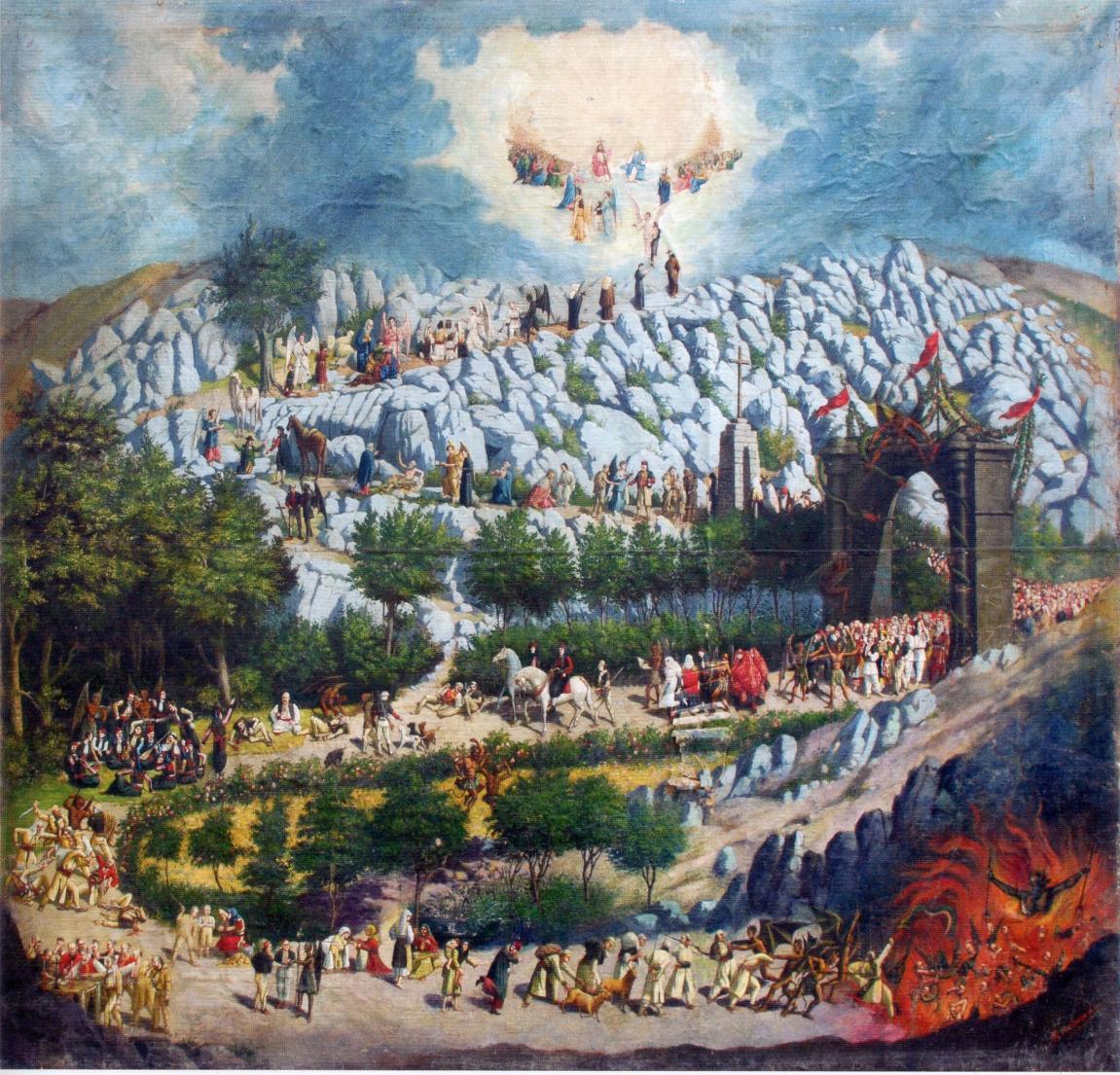 The painting ‘Two Roads’ by Kolë Idromeno, from 1893, when Albania first began to petition the European powers of the time (Britain, Austro-Hungary and France) for independence from Ottoman rule. The painting shows the artists view of the two paths open to the future of Albania: either they could follow the way of Ottoman rule into Hell, or ascend to the limestone mountains away from the Ottomans to paradise. I feel that the karstic depiction of Heaven in the painting is no coincidence, though there is some cognitive dissonance to cavers in depicting a limestone mountain as paradise and the world beneath the mountains as Hell…
The painting ‘Two Roads’ by Kolë Idromeno, from 1893, when Albania first began to petition the European powers of the time (Britain, Austro-Hungary and France) for independence from Ottoman rule. The painting shows the artists view of the two paths open to the future of Albania: either they could follow the way of Ottoman rule into Hell, or ascend to the limestone mountains away from the Ottomans to paradise. I feel that the karstic depiction of Heaven in the painting is no coincidence, though there is some cognitive dissonance to cavers in depicting a limestone mountain as paradise and the world beneath the mountains as Hell…
So, on with the story of our caving exploits. We met up in Leeds, Luke having shaved his beard in fear of the Albanian authorities invoking the now abandoned law limiting facial hair [Hoxha banned all hair longer than 4cm for men, as well as all beards]. After a tedious bus and train journey from Leeds to Gatwick, we met the others in the airport bar. We would be flying to Tirana, the capital, then be picked up by friends of Luigi Cekaj, the owner of Hotel Alpini in Lëpushë where we would be staying. Our lift arrived as it was getting dark, and we sped out of Tirana in a large Mercedez minibus with no seatbelts. We stopped briefly in Shkodër for our driver to have a quick raki and a smoke before heading up the mountain road to within a stone’s throw of Montenegro. Apparently this road had been unmetalled until this year, and the 4-hour journey from Tirana had previously taken 12 hours. Hoxha placed much more importance upon developing a binker network than other infrastructure. Imagine how many bunkers we’d have seen if it had been light though…
On arrival we sleepily ate some absolutely delicious food that had been put together for us by Luigi’s son Leonarda. This was to become a theme of the trip: I have never eaten so well on an expedition before or since and if we hadn’t had to do a big walk every day before exploring the caves we would all have got very fat. Albanian food essentially takes the best from Mediterranean and Middle-Eastern cuisine and marries the two absolutely sensationally. The food was a real highlight of the trip, as you will see from the detail with which we described it in the logbook we kept. Albanians are incredibly hospitable people. One of their unwritten traditions, basë, dictates that if they allow you into their home they will take care of you unfalteringly and will even defend you with their life.
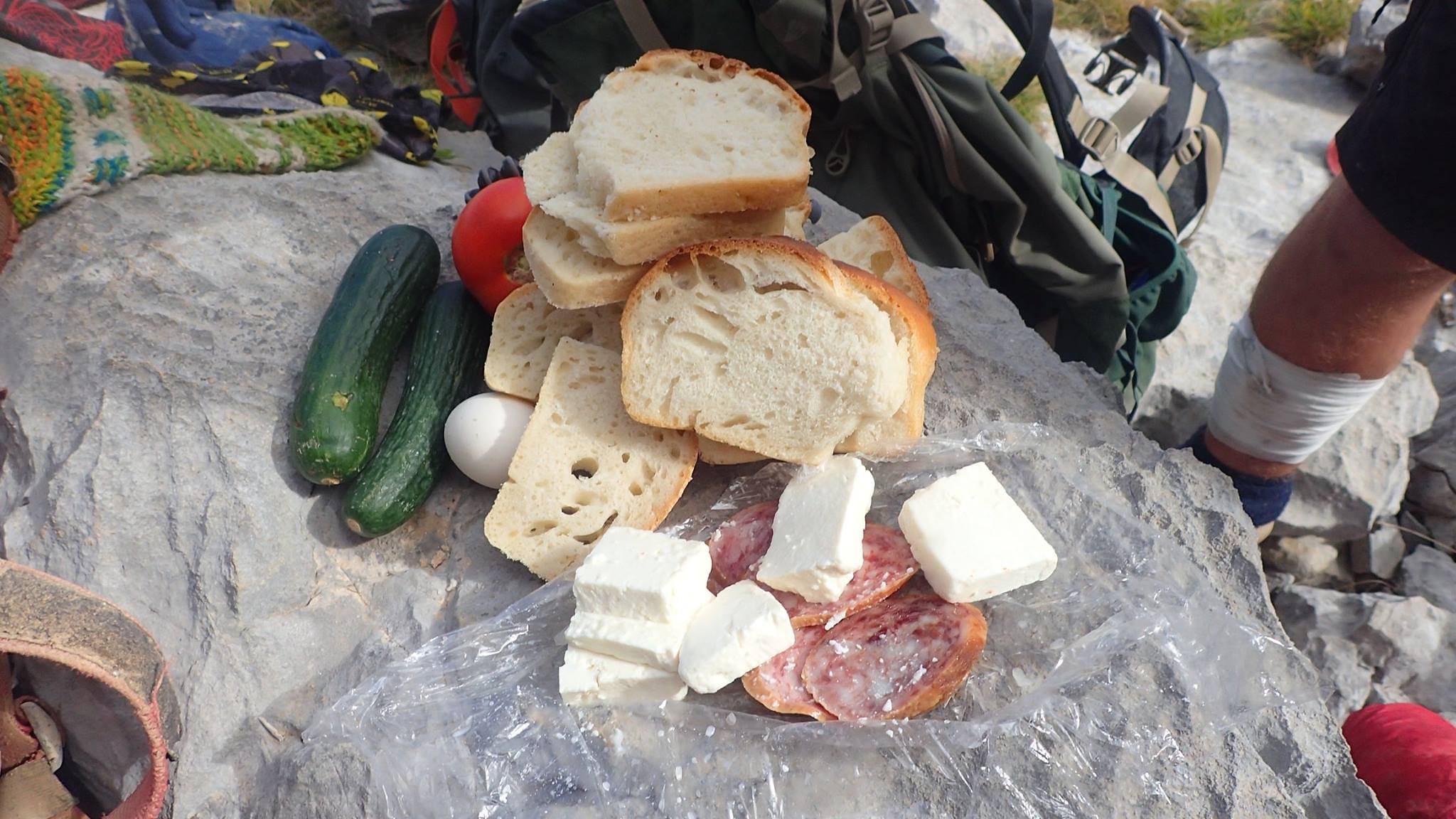 Typical example of packed lunch we took up the hill. Bread was baked fresh twice a day.
Typical example of packed lunch we took up the hill. Bread was baked fresh twice a day.
We kept a small logbook of the trip which George managed to locate recently, I’m really glad he found this as it brought back some great memories. I’ve reproduced that below, supplemented by other anecdotes that I remember and some pictures (all by Luke or myself unless it says otherwise). We surveyed all the caves we visited but have never got around to drawing them up, however now I have some time so hopefully they will be done this year… I did also say this in 2018…
Day 1 - George
Breakfast: usual bread and feta spread with coffee starter plus array of jam and honey with foreskin dumplings - big tick. [The coffee and tea in Albania are amazing, though many Albanians start the day with raki instead].
Recce of the area: first went to 519 aka Dragon Cave/Kalashnikov Cave [the Eldon guys found a full Kalashnikov clip at the bottom of the entrance shaft when they first descended]. Dumped majority of the gear here and then went for a wander around the area, looked at ‘Rat Hole’ and a few surface shafts including something left rigged from last year and refound 505. Poked around 506 whilst Dave pulled rocks from nearby surface dig. Then down to Lëpushë an alternative way.
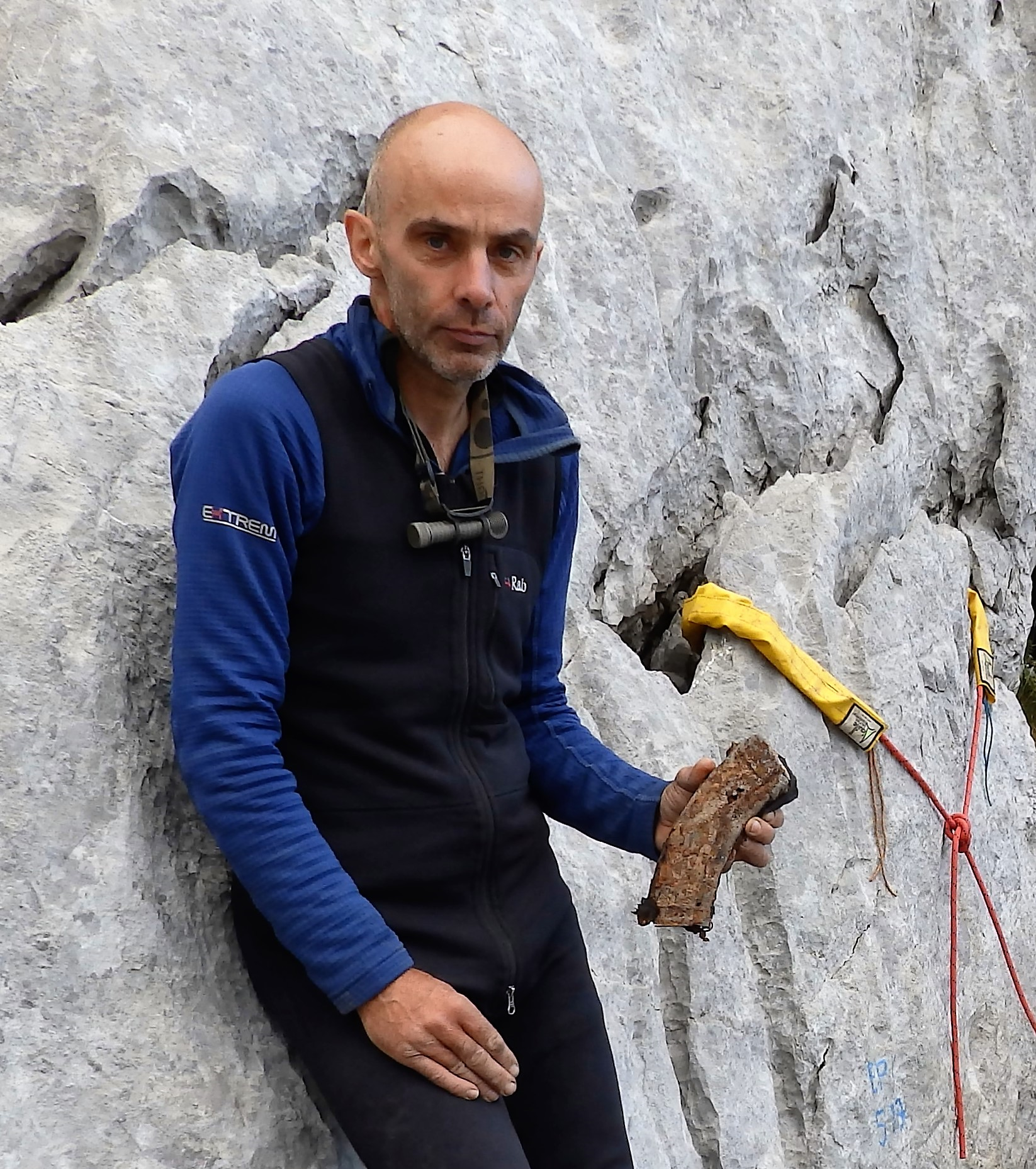
Dave in front of 519 aka Dragon Cave aka KalashniCave, with the round of ammunition they found at the bottom of the entrance shaft. Likely to have come from a shepherd apparently. Photo: Rob Eavis?
Dinner: breaded spam with potatoes and usual selection of pickled tomatoes, roast aubergine, salad and bread with copious feta. Wine and plum raki - yum yum.
Day 2 - Rob
Up at 8am, closer to the goal of living by the sun. Excellent breakfast, the base staying the same but with the dough foreskins replaced by crispy fried eggs.
Arrived at gear stash at 11. Much mistier than the day before, this being due to the lack of gear to carry up. After acquiring gear from 519 we headed to 505 to drop the pitch reached prospecting the day before. I rigged while George and Luke surveyed. Dropped a blocky 30m pitch series down to a nice series of small climbs down a meandering canyon (trickle of water present). It was sounding pretty big up ahead so I raced on and placed the last 3 bolts to drop the next shaft. Hit the bottom whereupon the cave ended in a mud choke.
George and Luke surveyed to the bottom and took photos of the excellent sediment towers. [We also found a lot of animal life in the entrance of this cave, including and a moth along with a vertebrae - unsure how old or from what animal, maybe from a sheep?] Then out and down the hill. The others returned around 4 hours after we arrived in Lëpushë (they had continued to push 519). We didn’t worry but were curious [we tried to be back before 8pm every day so as not to keep Luigi and his family waiting for us].
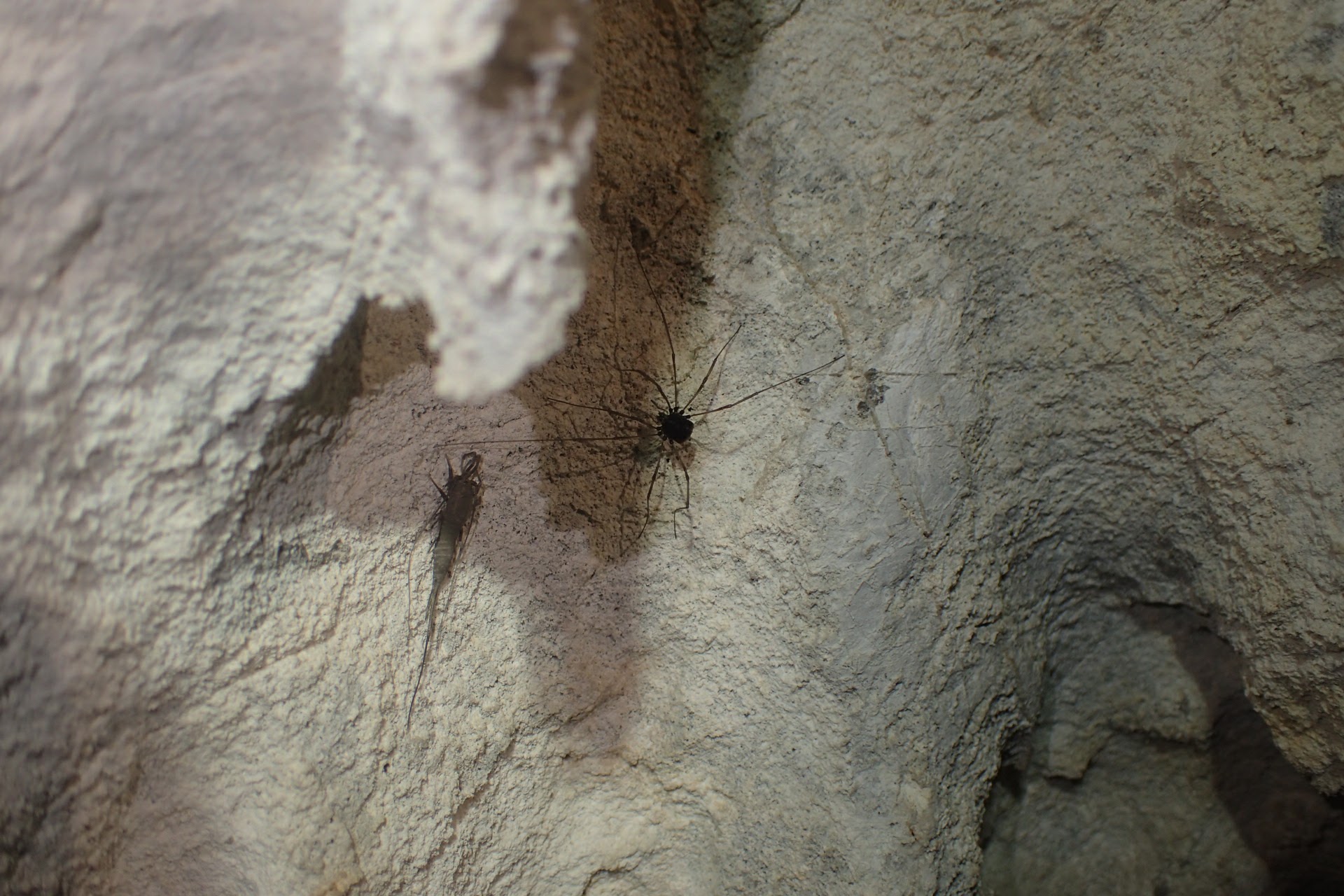
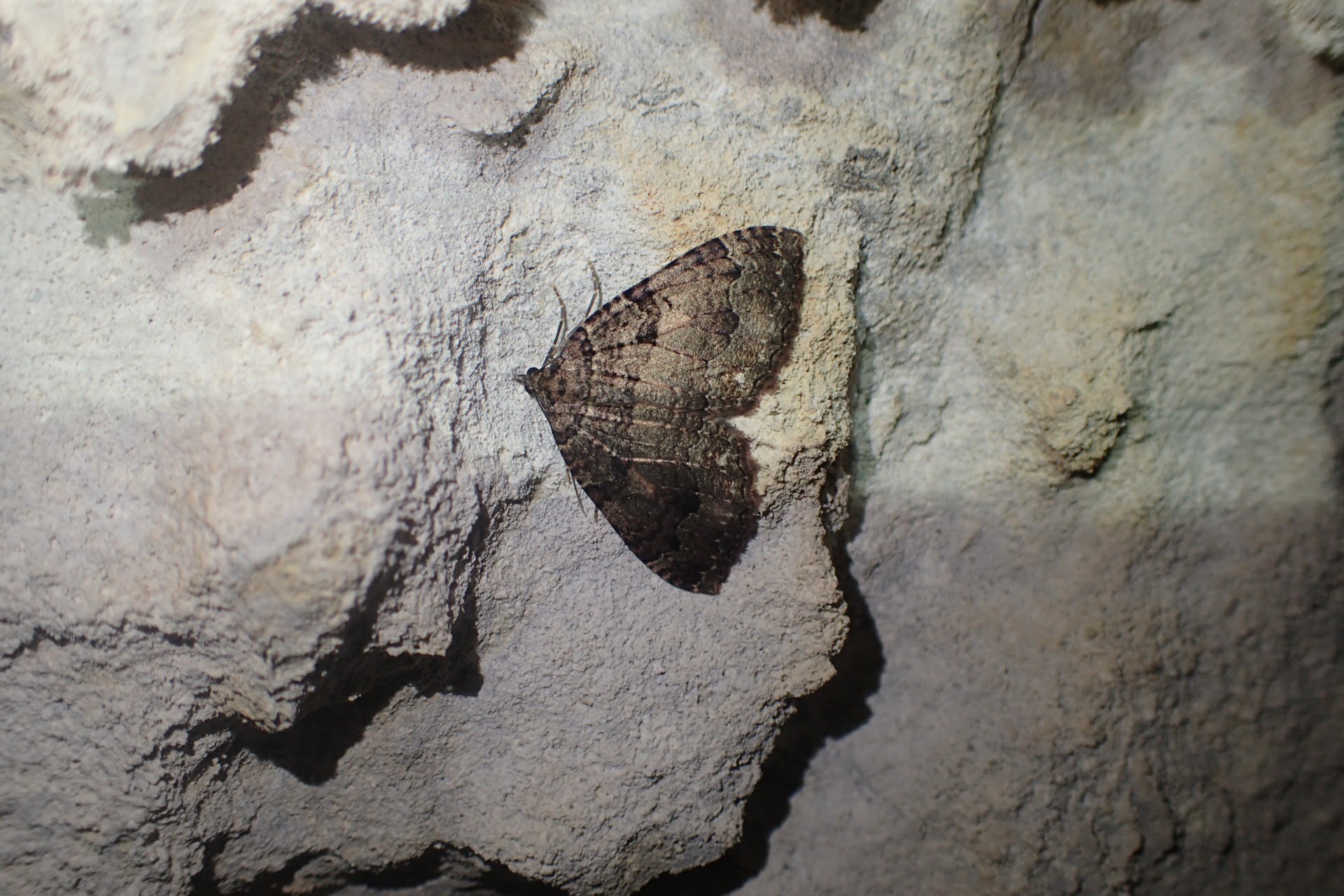
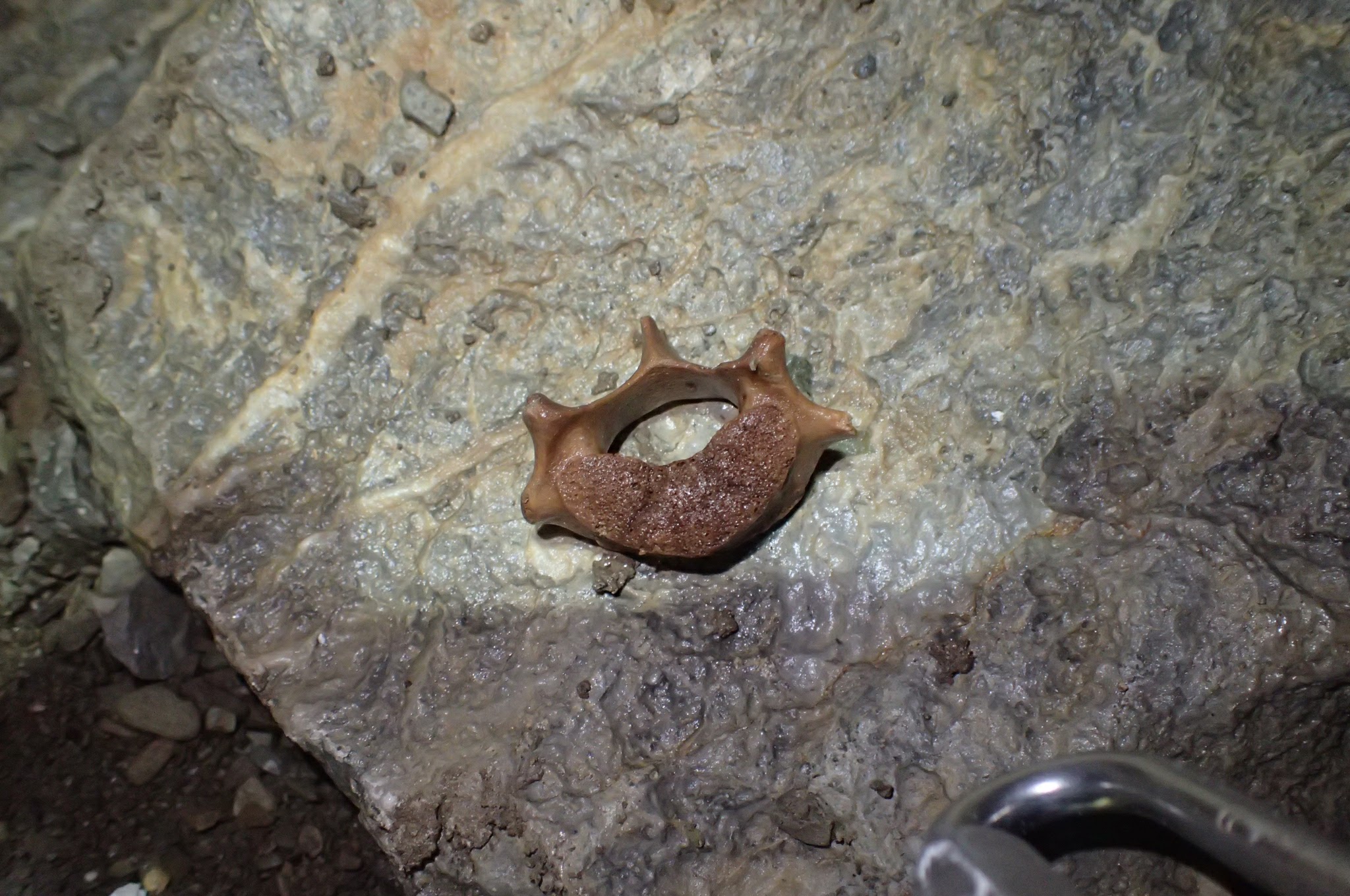
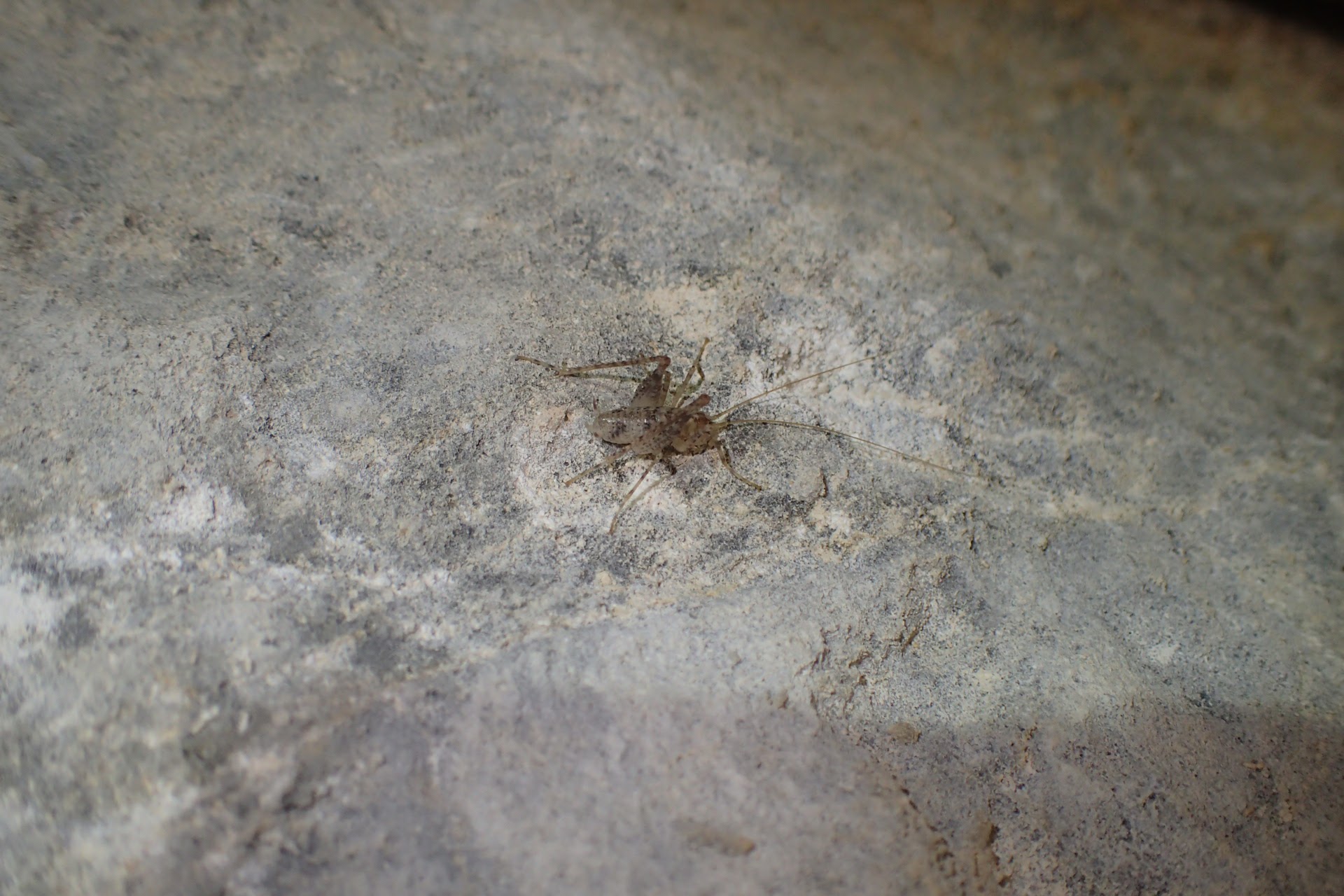
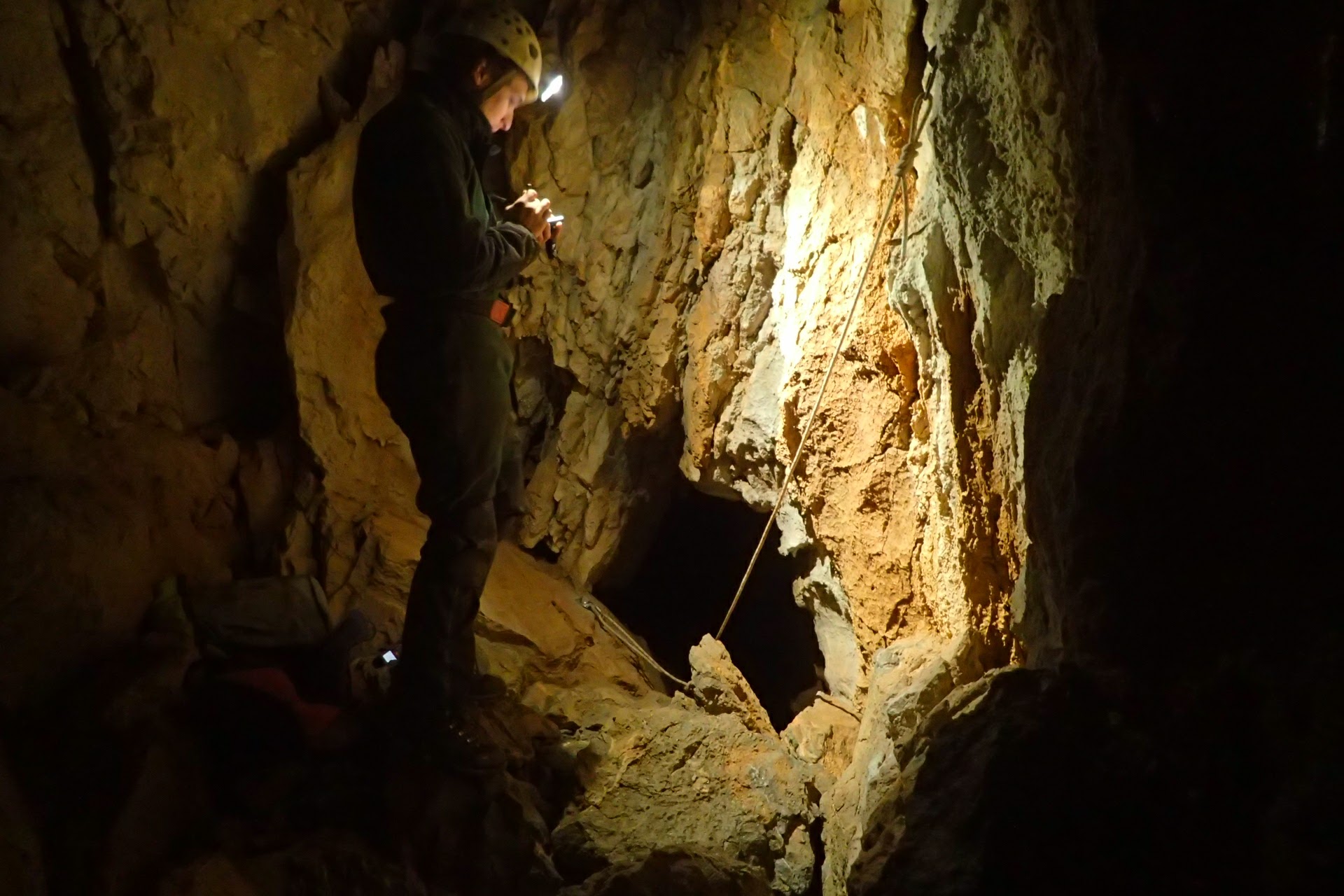
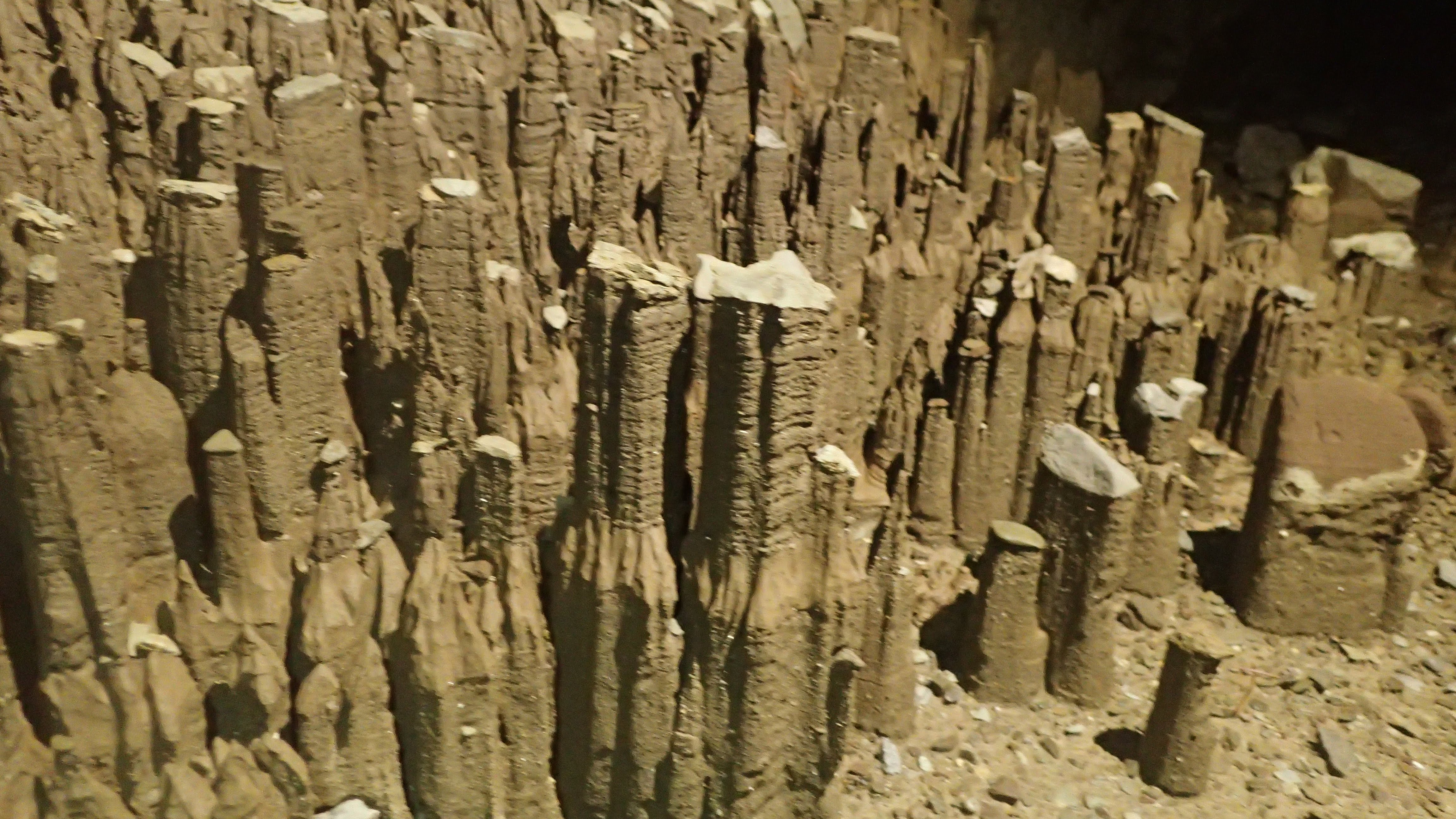
Images from 505. All the animal life was found near to the entrance, the sediment towers were at the bottom. Top row: spider and an insecty thing, and a moth. Middle: vertebrae, probably sheep, and a hopping thing. My knowledge of entomology shines through. Bottom: George surveying on the PDA at the top of the first pitch, and sediment towers at the terminal mud choke. Zoom in to get a better look at the details in these pictures, resolution is preserved.
Day 3 - Rob
Decided to continue exploring the partially rigged cave with a snow plug in the entrance shakehole. Luke headed down to commence bolting whilst George and I surveyed from the entrance. Luke dropped one more 20 m pitch and then needed more rope. We sourced this and he continued rigging down the next drop. The rigging here became problematic as all the rock was bad and a significant rub point had been incurred. A deviation with a tackle sack as a rope protector was employed and Luke reached a small hole behind lots of ice which he didn’t like so I was sent to continue rigging. The rock continued to be bad leading me to employ some quite unconventional rigging techniques. We left the cave looking down a ~30 m shaft, promising. Salamander festival on the walk down.
Day 4 - Rob
A slow start after too much raki the night before. Arrived at the cave around midday, ate lunch on surface and faffed to extremis. Underground at ? Tried to fix some rigging but after failing to find a better deviation George resorted to putting a rope protector in the middle of the hang. This is shit, never do this unless utterly necessary. Further fettling and fixing. Soon hit pushing front, dropping 15 m more only for cave to crap out in a huge impenetrable cobble choke hidden round the corner. Wank.
I was very useless all day.
Derigged everything we had done then home. Cave overall very miserable, wet and cold and felt quite dangerous with big moving snow/ice plug threatening to slide into the hole and block us in and shit rock. Glad to leave. Ice screw deviation only redeeming feature.
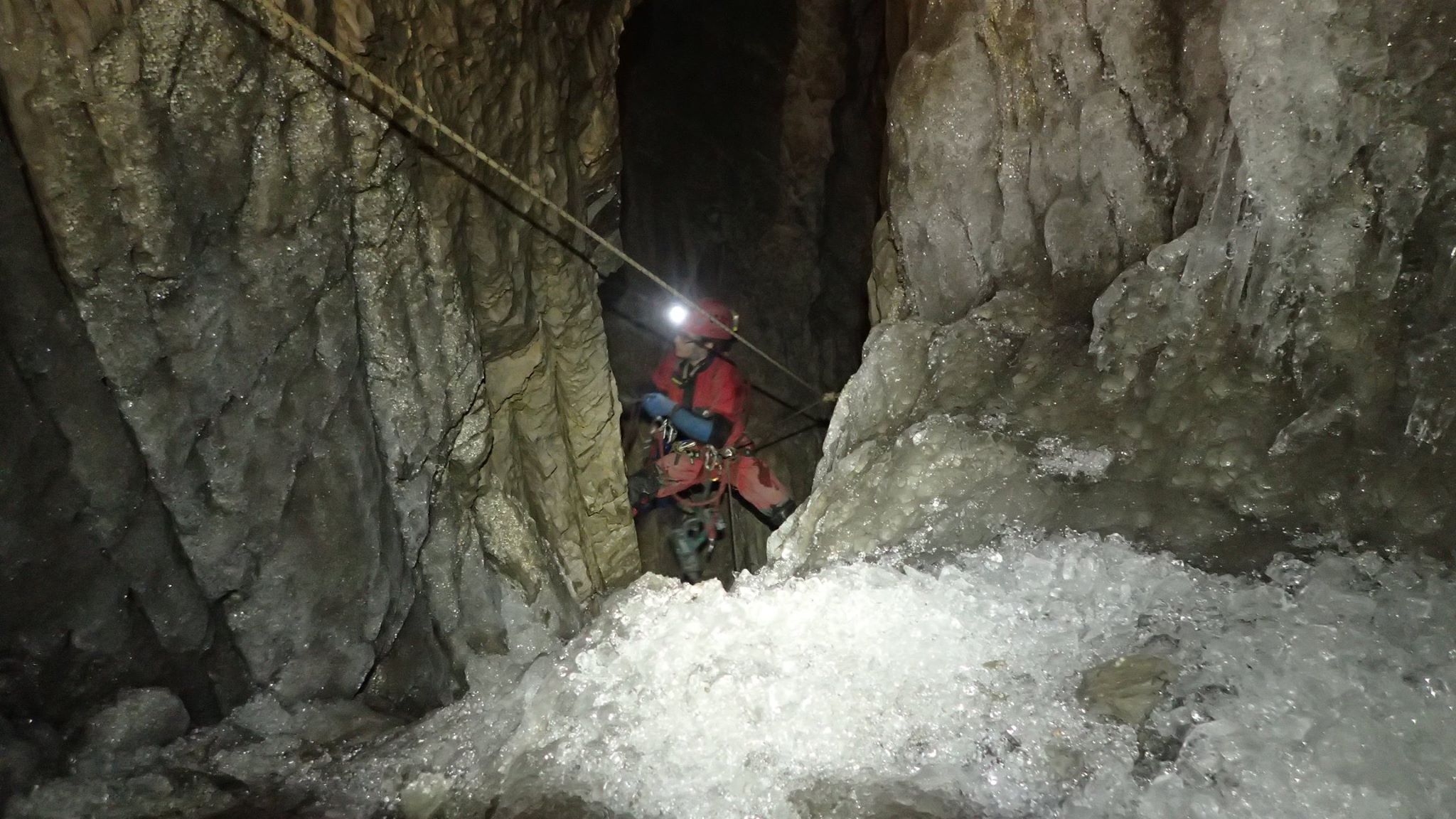
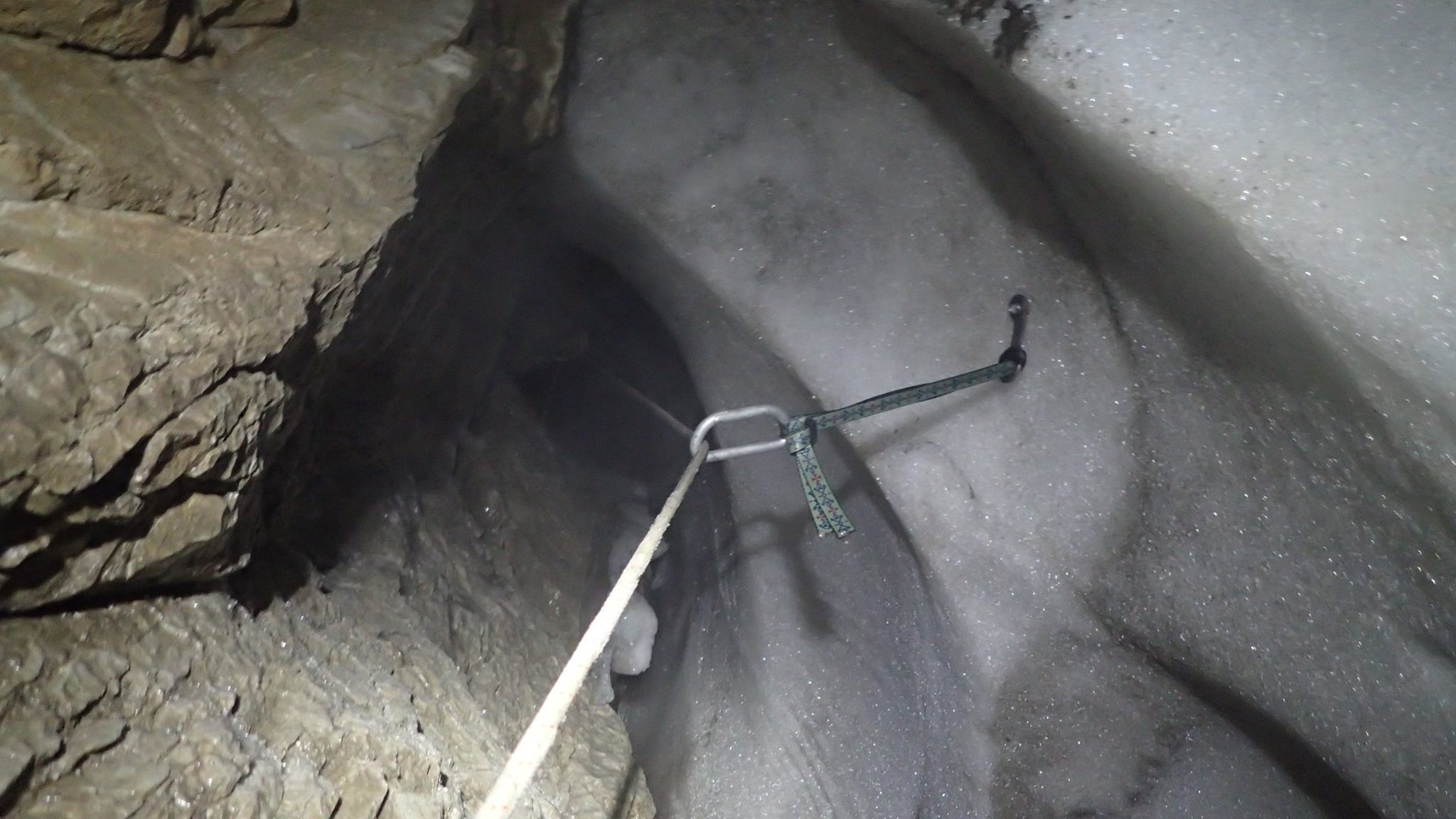
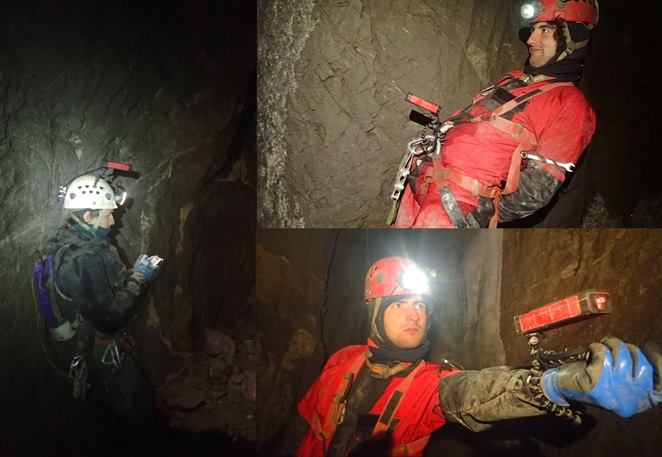
Images from the icepiece cave. As you can see it was a bit cold and miserable. George and Luke got a bit fed up waiting for me to rig in there so used their time innovatively to develop new surveying techniques.
Day 5 - Luke
Despite good intentions the night before not drinking raki still only up at 8. Foreskin dumplings were back. Almost went to the shop [there was a little shop/bar in Lëpushë which Barny frequented every day to have a strong espresso and get chocolate and cigarettes]. Saw a blind man with ‘guide cow’.
Another apathetic day really. Lunch was had on the surface above a rift. Hunt and fish option on the GPS deemed very useful but positional accuracy was the same as my phone. Entrance shaft dropped after lunch using a natural and bolt, crapped out immediately. I proceeded to kick an apple down it. Continued looking found another suitable hole which was rigged completely on naturals. Jumping over another hole on the karren field (stupid) Rob smashed his shin cutting it badly.
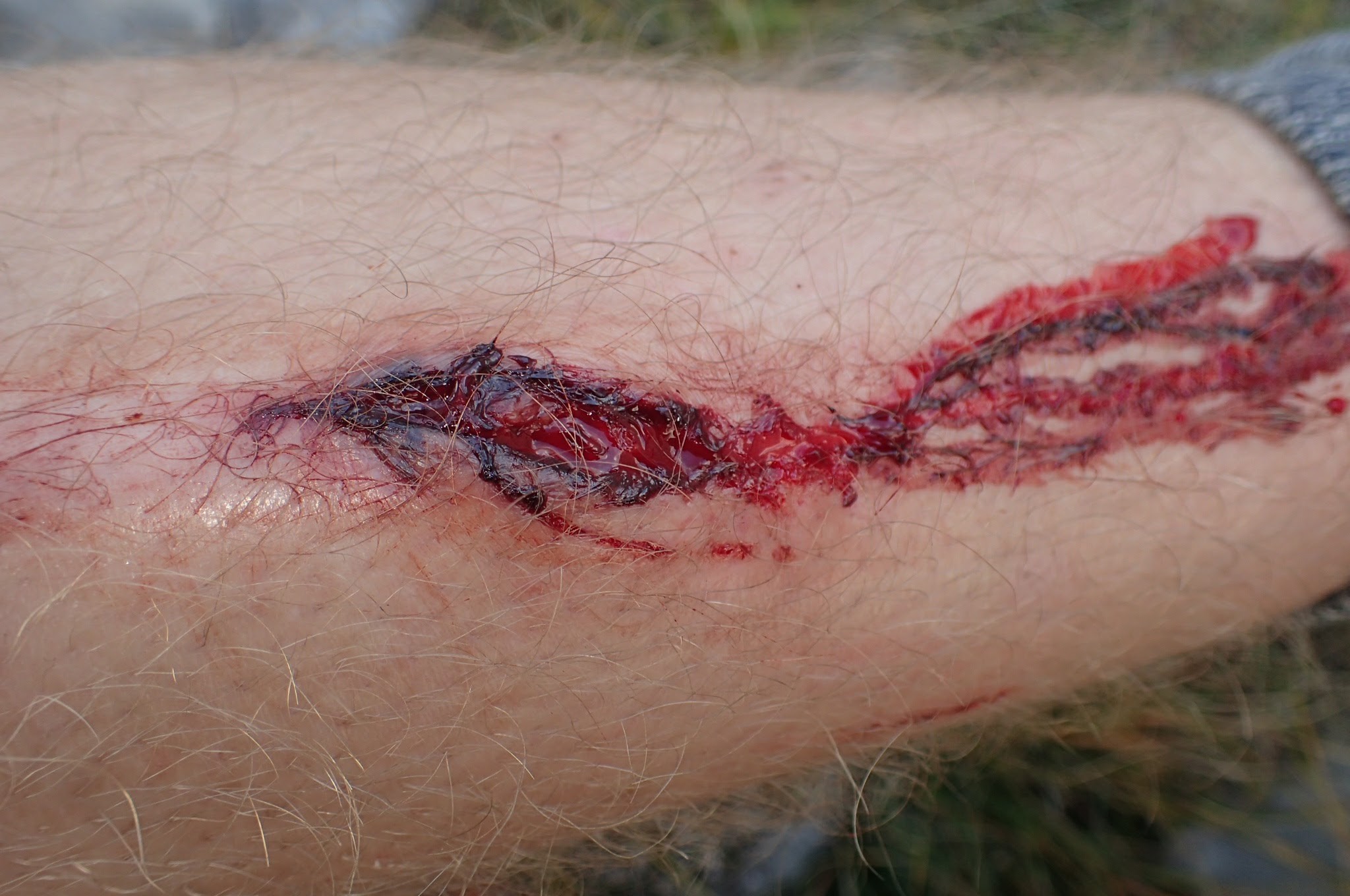
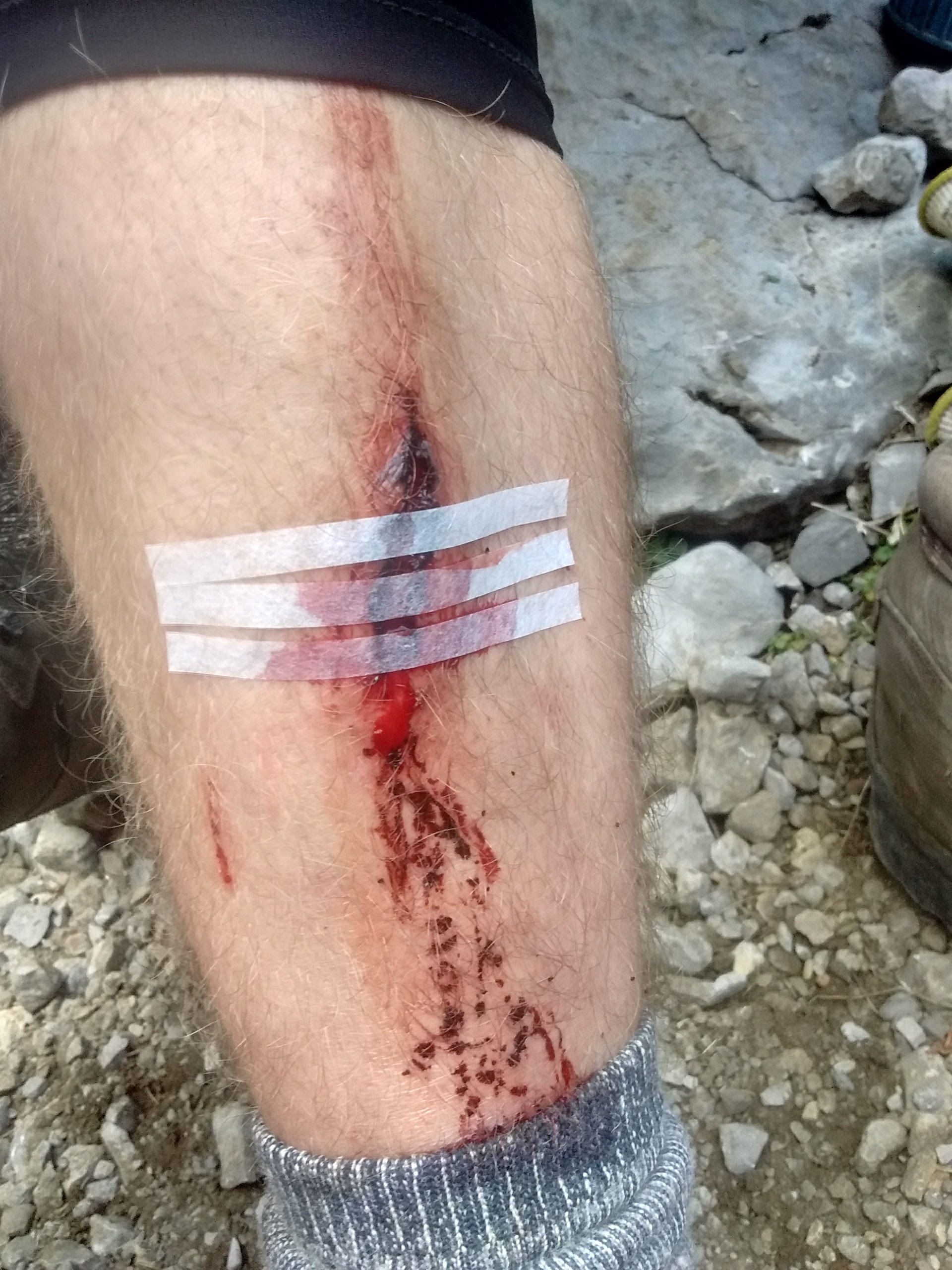
My knackered leg. On return to Leeds it proceeded to get infected for a bit. Nasty.
Transported our stuff back to 519 ready for tomorrow. Headed down early using the injured leg as a convenient pretext for going to the red shipping container bar (‘Bob’s bar’) where someone spoke perfect English (had lived in London), making ordering beers very easy.
Dinner: Chicken drumsticks and potatoes. Cog soup. Coconut cake?
Day 6 - Rob
As requested for much of the week, we headed to 519 to check out the rift at the bottom and survey the entire cave. I had the job of posting whilst George and Luke surveyed. I carried quite a heavy bag of drill and metalware down the cave, foolishly also picking up a bag of rope that I thought was for me en route (it transpired that on the last trip Barny had done exactly the same thing). Once at the rift I spent a lot of time moving the bags through the rift until I reached the limit of the Eldon guys’ rigging, marked by the presence of another rope bag. Fucks sake.
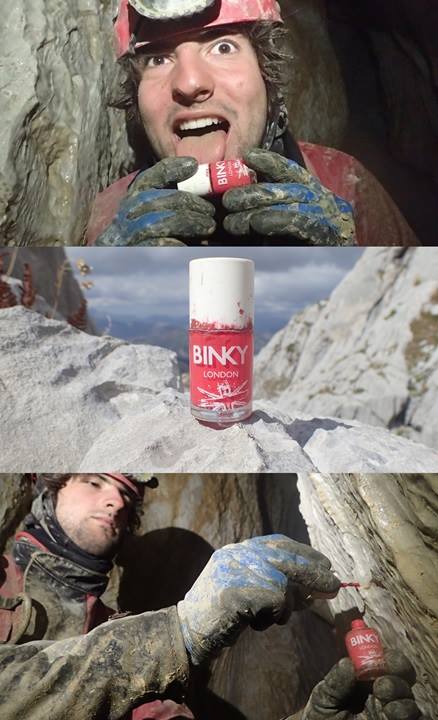
Luke trying hard to get a sponsorship from Binky, a beauty products company run by a star from ‘Made in Chelsea’, which we had been using to mark survey stations since needing to get some in Ingleton Co-op for a Fountains Fell surveying trip. Binky is the go-to for survey station marking.
I then continued down the rift to drop a new 6 m pitch. The rock was flaky and of low quality. I progressed further to another drop of about the same depth. Then George and Luke caught up. By this time it was 6pm, my leg was getting painful and the other two were bickering about the surveying so we headed out, leaving the drill at the pushing front so we didn’t have to lug it out and in again. On the surface at 8pm, around 1.5 hours to surface from the pushing front. Mr Moon was exceptionally bright, incredible. Back at Luigi’s just after 10 for stuffed peppers, big yum.
Day 7 - Rob
Back into 519 to continue pushing the rift and retrieve the drill before we left in 2 days time. Much quicker on the way in this time, arrived at the front in an hour. Ibuprofen and codeine for my leg were a great improvement on just bandage yesterday.
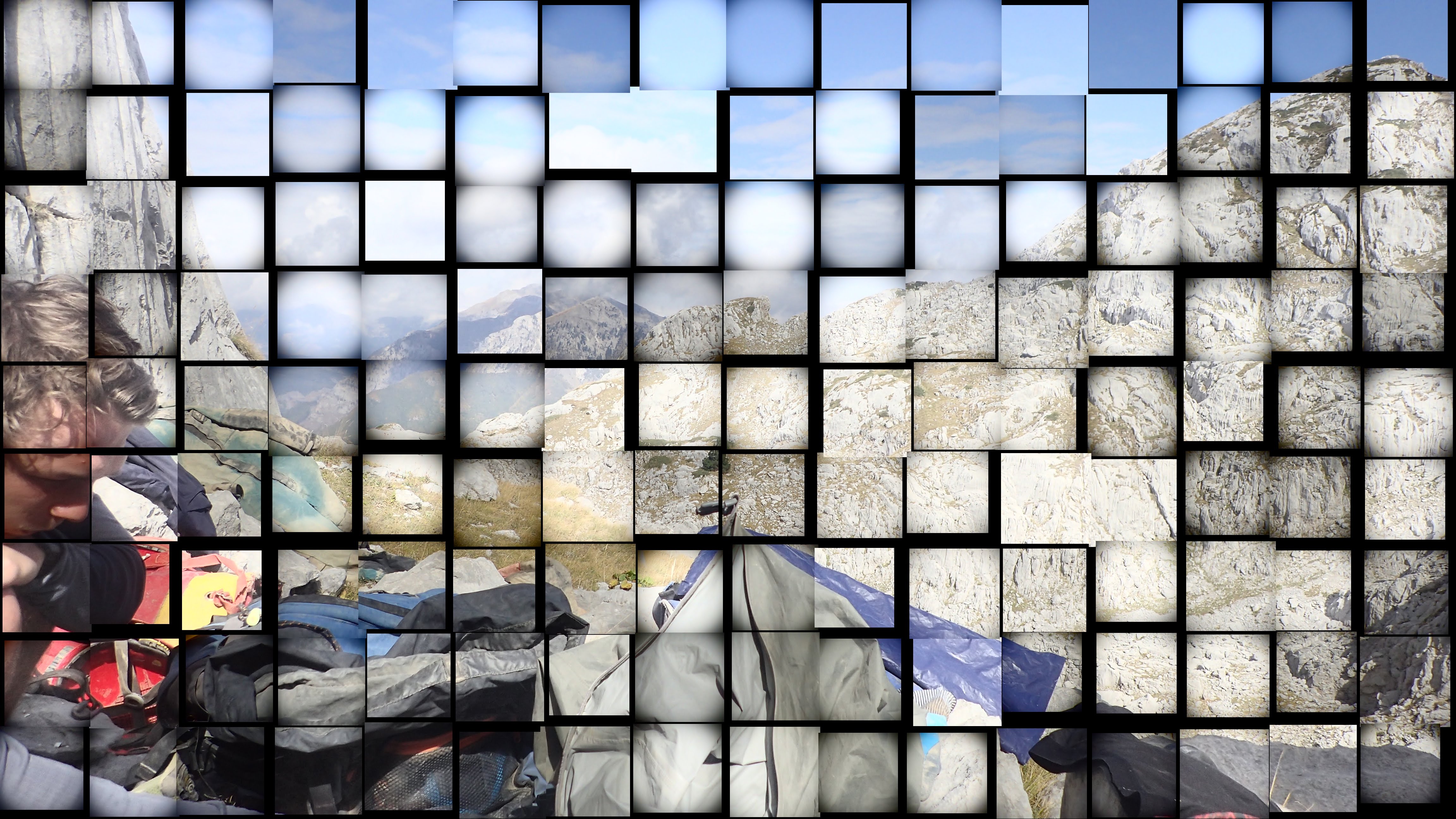
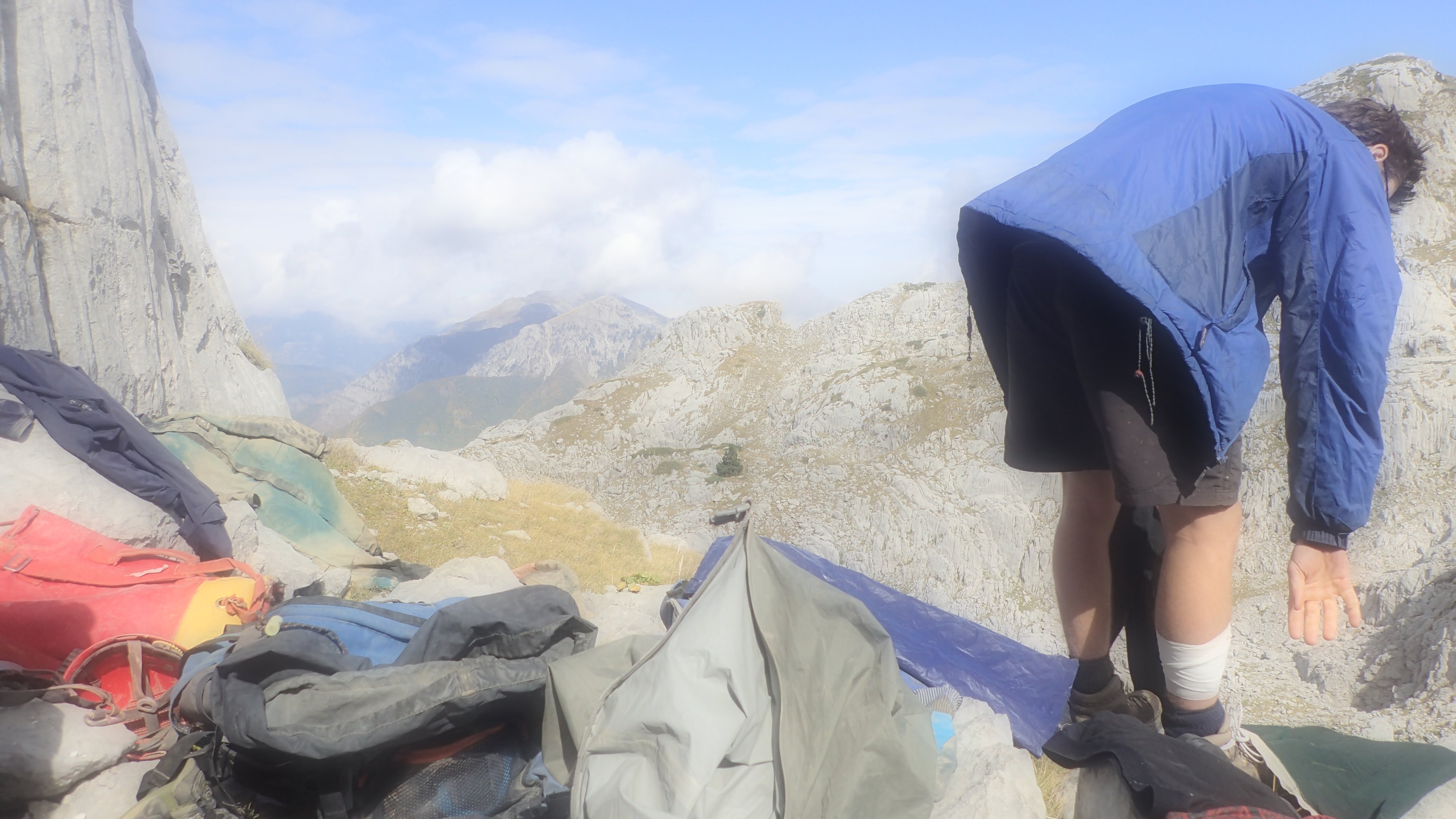
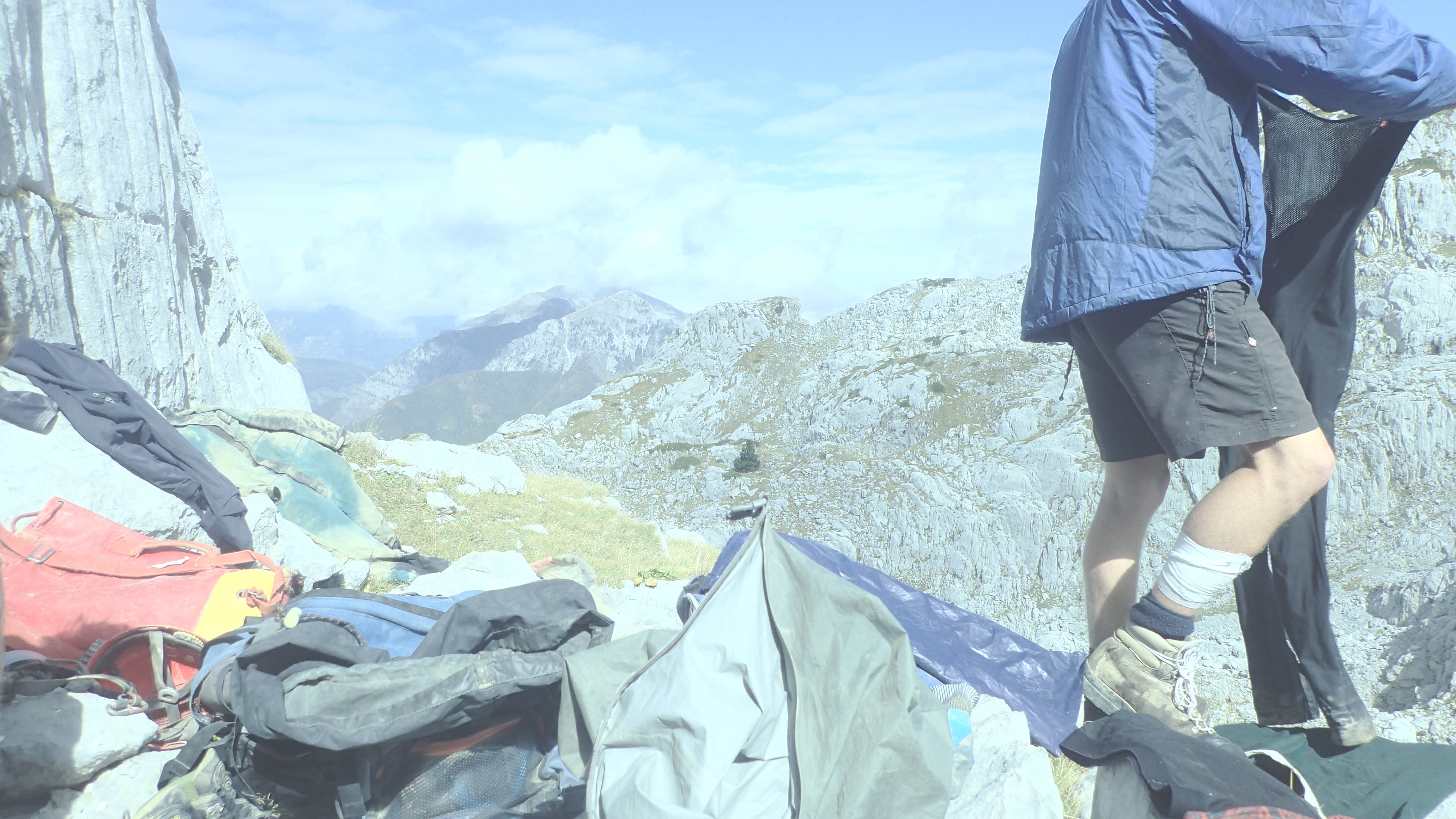
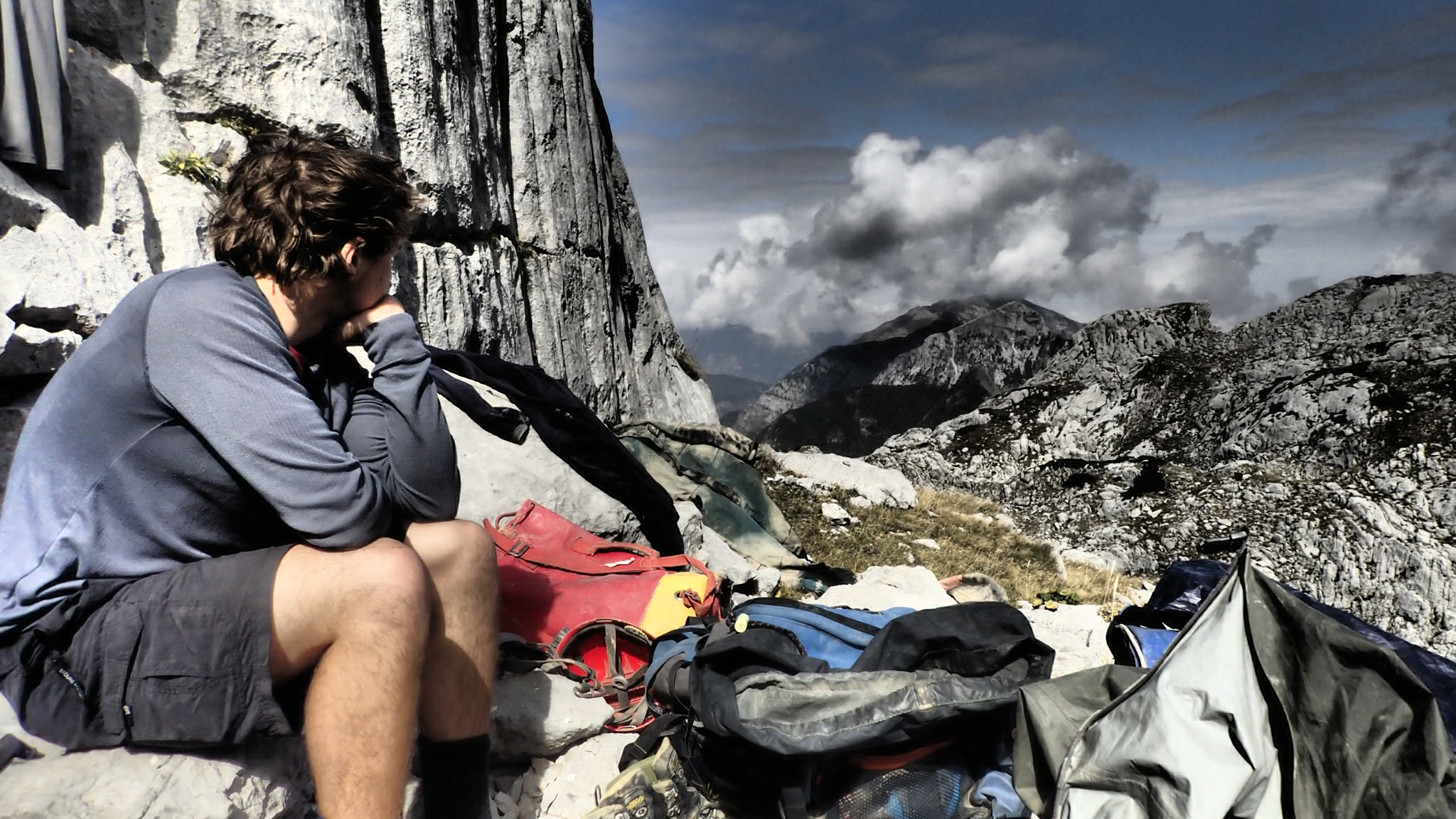
I’m not sure what Luke consumed beforehand (maybe some secret raki and my codeine?) but he sure did have a good caving trip that day. I’m surprised he left the surface…
Started bolting, echo confirmed much bigger space beyond. Dropped around 12 m pitch into spacious canyon, with much improved rock quality. Climbed down 3/4 m then another 6 m pitch. Rift continued beyond, very similar (1 - 1.5 m wide, very high) and trending along the same direction with some small meanders. Arrived at another 6 m drop that couldn’t be climbed safely but only had 1 bolt left so placed that then drilled a small thread on a lip and equalised it to the bolt with my emergency prussik cord. Headed down and only more of the same, so with time ticking on we abandoned proceedings here and headed out. Ran into Dave and Ade near the entrance as they finished their exploration of a parallel shaft series. Then headed down the hill with all our gear to reduce the amount we would have to carry the next day, which we had consigned to a surface day.
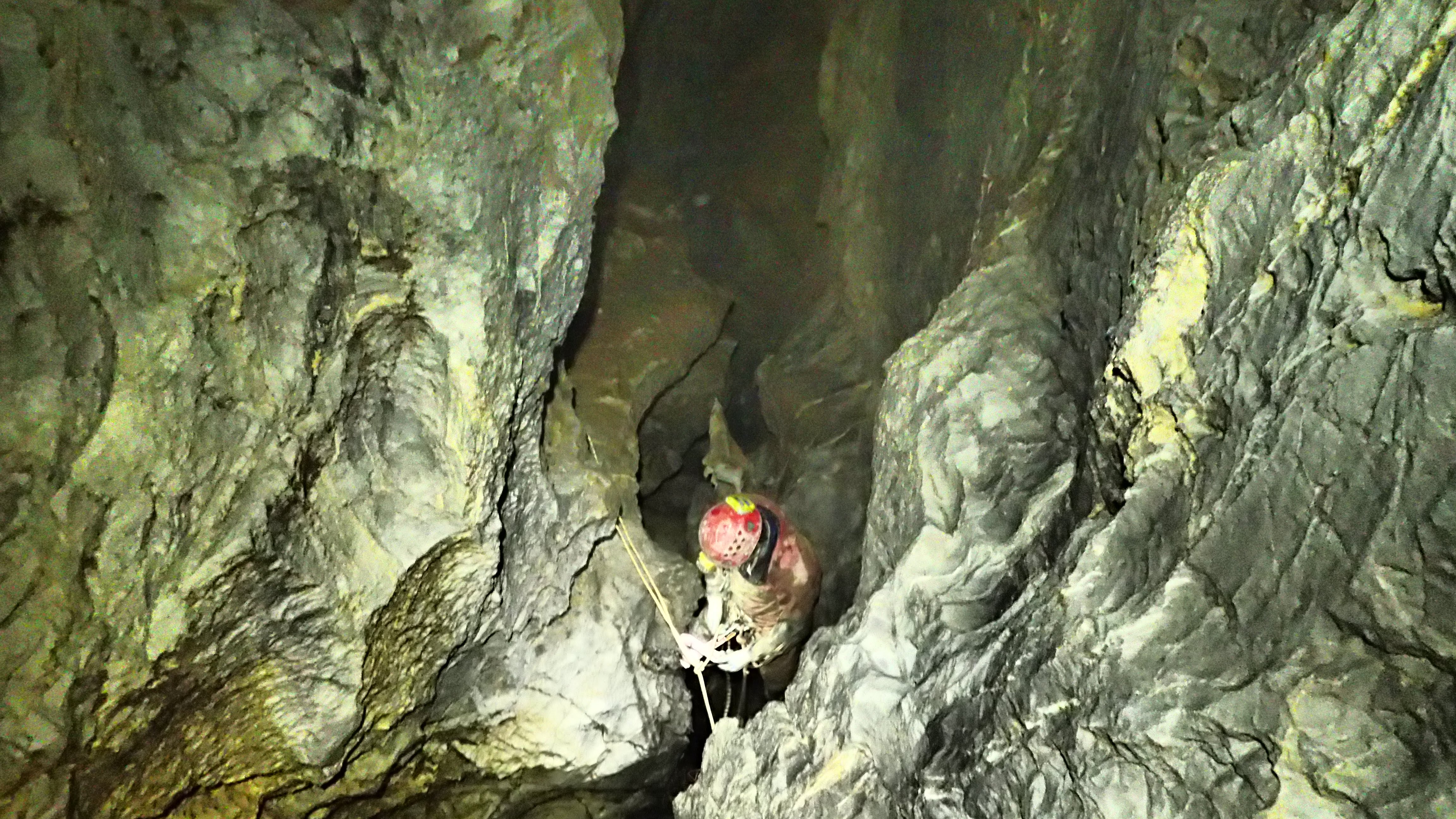
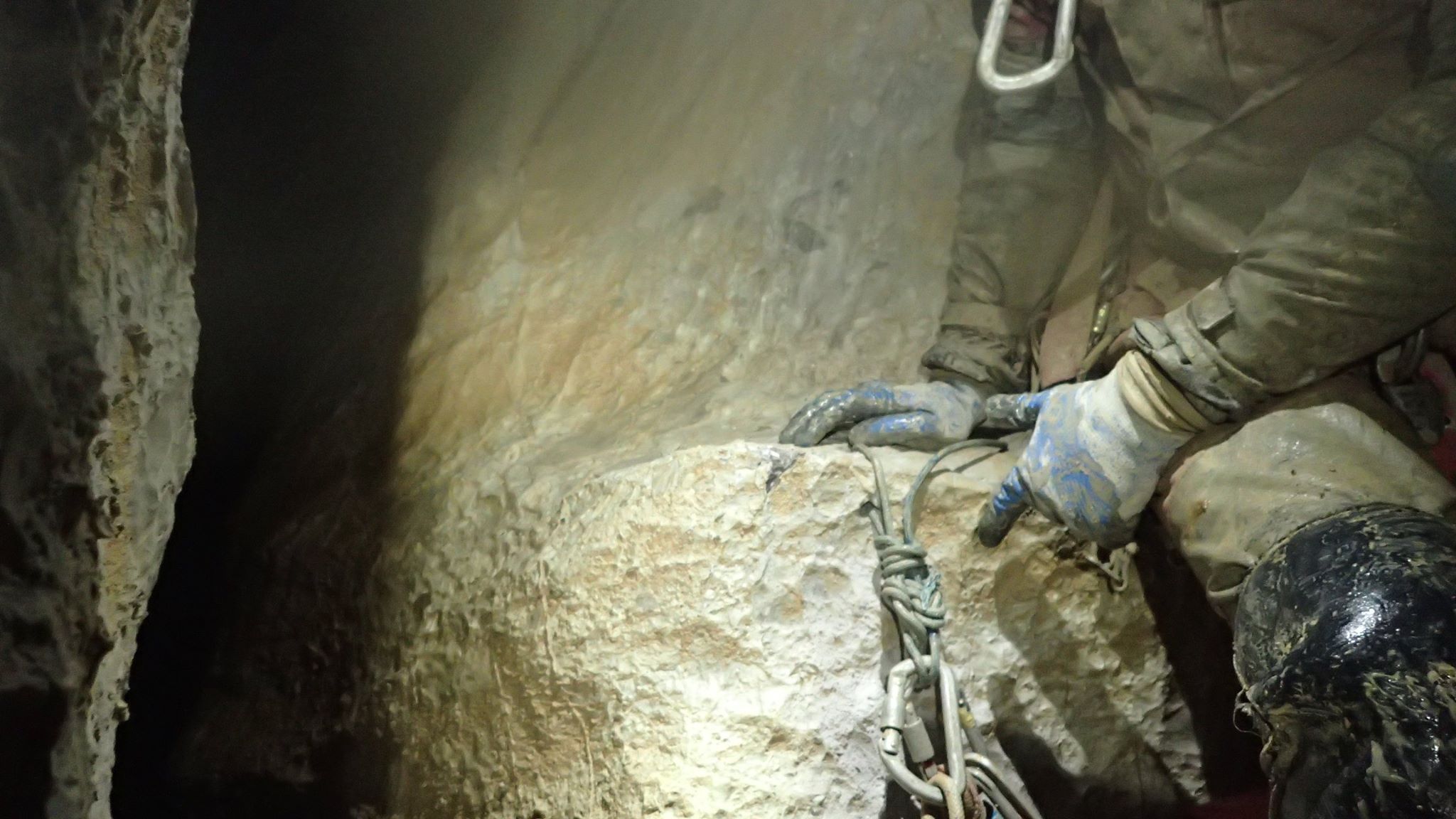
Rigging in 519. The rock in the caves varied between excellent clean dolomitised limestone and utter cheese rock. Fortunately, in this rift the rock was solid, making up for the slippery mud coating the walls. Caving in Burnies Pot and PL2 on the Hoher Dachstein was very similar to what we did in Albania in hindsight.
Food was aubergine soup followed by lamb and tab end raki. [There were various strains of raki on offer, ranging from sweet plum to classical white spirit/lighter fluid right through to one which tasted like tab ends and had some strange deposits in the bottom that were proclaimed by Dave to be ‘the teeth of sorrow and lamentation’]. All raki had to be consumed so that there was minimal chance of being productive the next day.
The next day was spent carrying our last things down the hill, drinking coffee, playing with the cats (there was a very cute kitten), having beers at Bob’s Bar, lounging in a sunny meadow and watching the piglets play in Luigi’s garden. There were two sizes of piglets: biglets, and smiglets. We would often see them playing happily in the morning before we headed off caving and come back in the evening to find one on our plates. Dave and myself are both veggies but we agreed that if you’re going to eat meat then this is the best possible scenario (apart from roadkill maybe?).
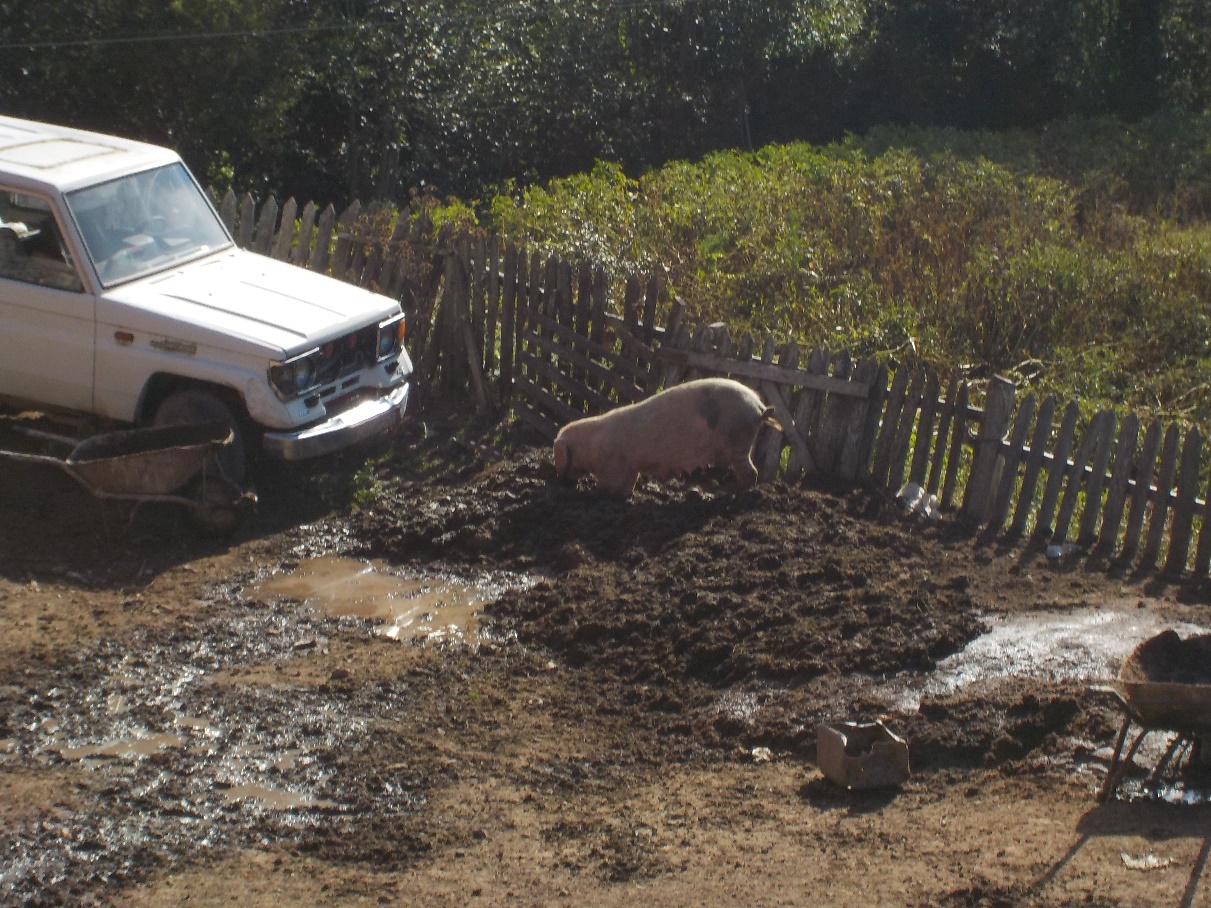
Very characteristic Hotel Alpini scene: pig wallowing happily next to Lada.
The next morning it was time to leave. It felt as if time had been standing still in the valley; the Kelmend Mountains are a really special place that I would love to return to one day. The journey to Tirana was in the Mercedez minibus again, though this time we were accompanied by several others from the village including a nun. Seeing the landscape in the daylight was incredible, with many excellent limestone slot canyons visible from the road. Canyoning expedition anyone?
The driver seemed dissatisfied with the performance of the van, and in Shkodër we stopped and he opened the bonnet, which belched a lot of diesel fumes at us. The van was done, at least for today. No matter, for two drivers of fast BMW’s were quickly summoned and we transferred into these for the next leg down the main road to Tirana, with only a brief stop en route at a nunnery where the nun disembarked. The main road was frequented by an eclectic array of vehicles, including a herd of cattle and a cyclist with a large scythe sticking out sideways to try and trick dozy drivers. [Funnily enough, I read the report from the Eldon’s 2016 expedition recently and the scythe cyclist was observed that year as well on the same stretch of road!]
Flew back into Gatwick for around 6pm then train and bus back to Leeds again. Think it might have been the ULSA pub night when we got back, can’t remember now.
 Looking south from the immense karst plateau. Lëpushë is just about visible in the background, in the valley on the left-hand side.
Looking south from the immense karst plateau. Lëpushë is just about visible in the background, in the valley on the left-hand side.
So that was that for Albania 2017. Huge thanks to Dave and Barny for inviting us out and to Luigi Cekaj and his family for hosting us. At Hidden Earth 2018, I ran into Bob Toogood, another Eldon member who hadn’t been able to make it in 2017 but was spoken of highly by Dave and Barny. We had a good chat about Albania and it brought back some good memories. Bob is certainly a character and quite infectious in his enthusiasm for caving.
Although there was no trip in 2018, in 2019 the Eldon returned to 519. Apparently it sumped just around the corner from the pitch we didn’t drop. Fucking typical, could have saved everyone a lot of effort with just an hour’s more caving! Never mind, it gave Rob Eavis and his mates something to do. In the aftermath of the Eldon’s 2019 trip, Tony Seddon made some brief noises about diving the sump, but I think there is a huge amount more potential above water before we need get started with that.
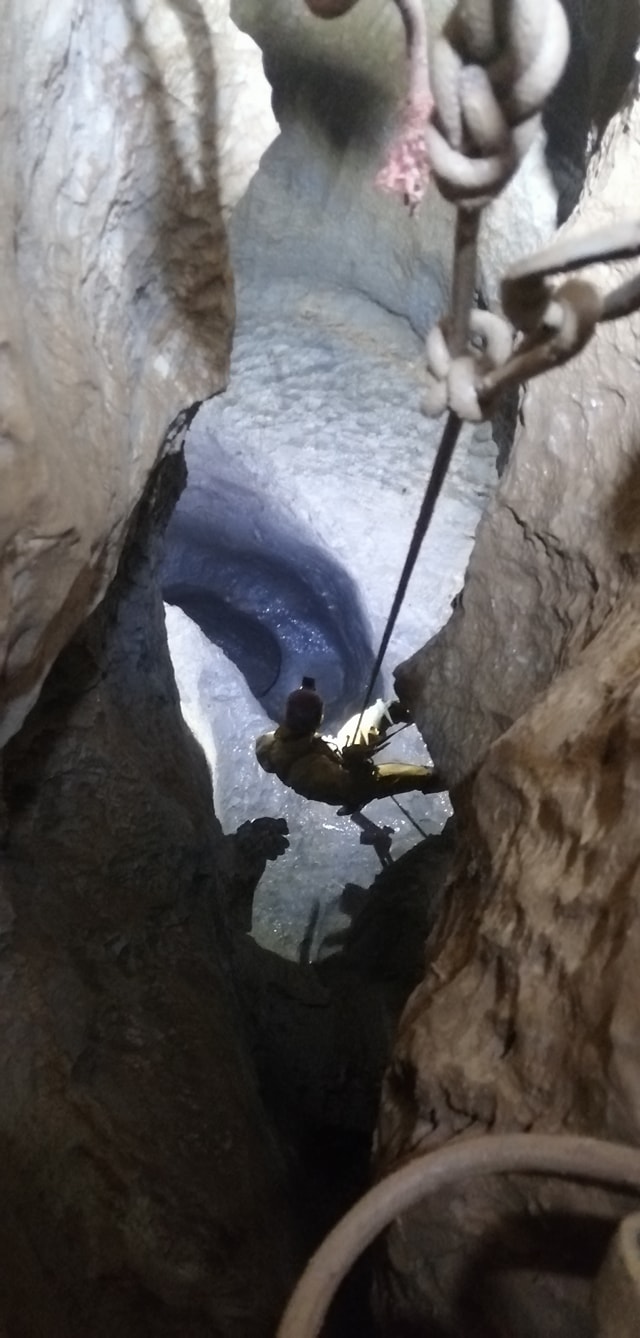
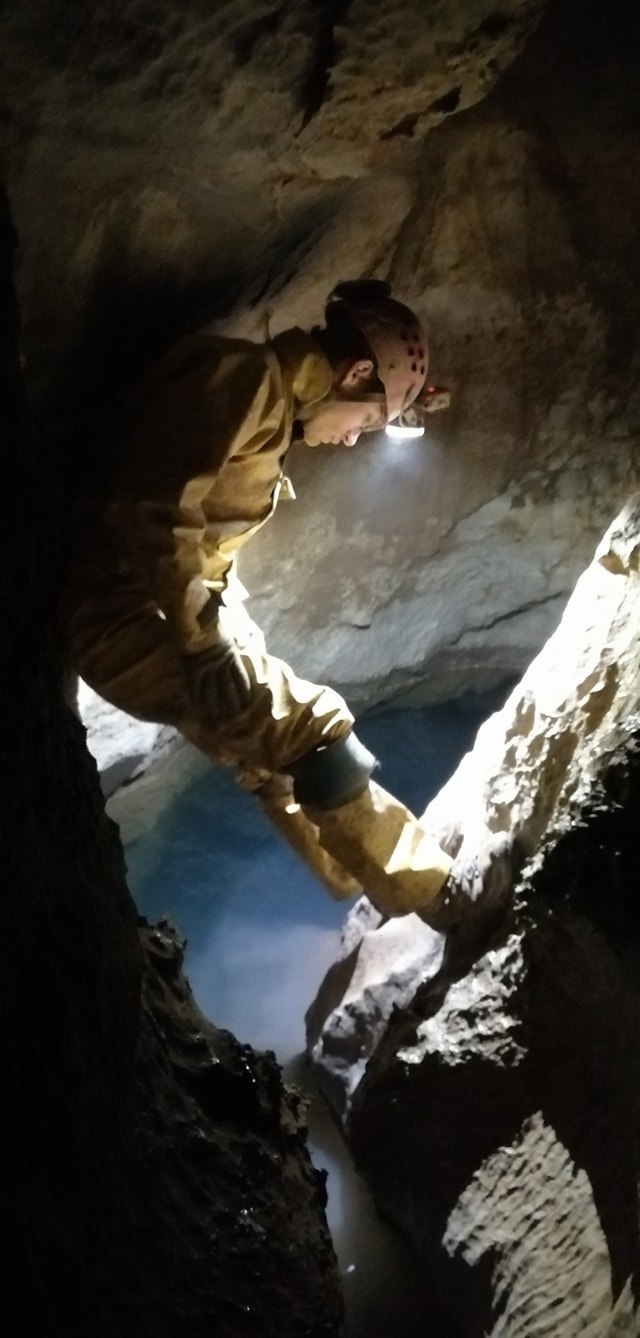
Final pitch dropped by the Eldon guys in 2019, and sump pool. Photos: Rob Eavis?.
The karst in this region of Albania had seen visits from a couple of other parties, including some Italians in the 1980s and the Axbridge Caving Group in the 1990s, but has otherwise remained untouched. With almost 1500 m of vertical difference between the 519 entrance at 2100 m (presently the highest known entrance) and the known resurgences in the valley at around 600 m (which are very high discharge in flood apparently with a big catchment) there is a monster cave system waiting to be found here, but probably not in 2020…
 Somewhere in here there is a lot of cave…
Somewhere in here there is a lot of cave…
